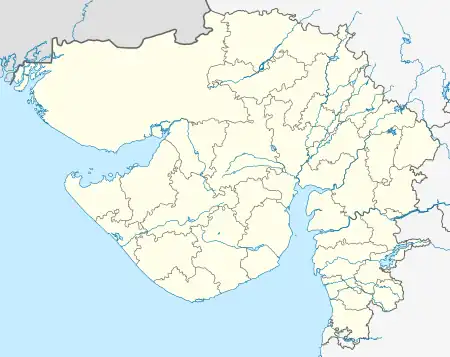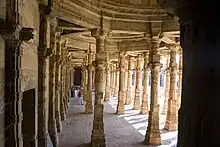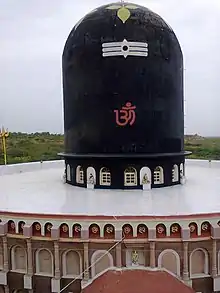Khambhat
Khambhat (/kɑːmˈbɑːt/, Gujarati: [kʰəmbʱɑt] ⓘ), also known as Cambay, is a city and the surrounding urban agglomeration in Anand district in the Indian state of Gujarat.[1] It was once an important trading center, but its harbour gradually silted up, and the maritime trade moved to Surat. Khambat lies on an alluvial plain at the north end of the Gulf of Khambhat, noted for the extreme rise and fall of its tides, which can vary as much as thirty feet in the vicinity of Khambat. Khambat is known for its halvasan sweet, sutarfeni, akik stone and kites (patang), and for sources of oil and gas.
Khambhat
Cambay | |
|---|---|
City | |
.jpg.webp) Tower Road, Khambhat | |
| Nickname: Trambavati Nagari | |
 Khambhat | |
| Coordinates: 22.3°N 72.62°E | |
| Country | India |
| State | Gujarat |
| District | Anand |
| Government | |
| • Type | Nagar Palika |
| Area | |
| • Total | 2,932.9 km2 (1,132.4 sq mi) |
| Population (2011) | |
| • Total | 99,164 (M+OG) |
| • Density | 620/km2 (1,600/sq mi) |
| Languages | |
| • Official | Gujarati |
| Time zone | UTC+5:30 (IST) |
| PINs | 388620, 388625, 388630, 388540 |
| Telephone code | 02698 |
| Vehicle registration | GJ 23 |
| Website | khambhatnagarpalika |
Khambat is perhaps the only place in India where the Harappan craft of agate bead making is found in the living tradition. Surprisingly Khambat has no stone deposits; the craft has survived mainly through acquiring stones from the Rajpipla hills, about 200 km away from the city. In the folklore of Khambat, the beginning of the craft is attributed to Baba Ghor, a 1500 AD saint from Ethiopia (Habash) who had led a large contingent of Muslims (Siddi) to settle in the city. However, in the archaeological record the origin of the craft can be traced to nearby Lothal, a Harappan outpost that flourished about 4000 years ago.
Toponymy
Origin of name
Some people believe that the City of Khambat may be the Camanes of Ptolemy. James Tod believed that the name comes from the Sanskrit Khambavati or 'City of the Pillar'.
Variants of name
- Cambay
Historical
- Cambaet of Marco Polo[2]
- Cambaia of Duarte Barbosa[3]
- Cambeth of Marino Sanudo[4]
- Trambavati of Tod[5]
- Kambáya[5]
- Combea[5]
- Quambaya[5]
- Camanes of Ptolemy[6]
History




Cambay was formerly a flourishing city, the seat of an extensive trade, and celebrated for its manufactures of silk, chintz and gold stuffs.[7] The Arab traveler al-Mas'udi visited the city in 915 AD, describing it as a very successful port; it was mentioned in 1293 by Marco Polo, who, calling it Cambaet, noted it as a busy port. He mentions that the city had its own king. Indigo and fine buckram were particular products of the region, but much cotton and leather was exported through Cambay. In the early 1340s, the Moroccan traveller Ibn Battuta remarked on its impressive architecture and cosmopolitan population.[8]
"Cambay is one of the most beautiful cities as regards the artistic architecture of its houses and the construction of its mosques. The reason is that the majority of its inhabitants are foreign merchants, who continually build there beautiful houses and wonderful mosques -- an achievement in which they endeavour to surpass each other."
An Italian traveler, Marino Sanudo, said that Cambeth was one of India's main two ocean ports. Another Italian, visiting in about 1440, Niccolò de' Conti, mentions that the walls of the city were twelve miles in circumference. The Kothi gateway traditionally believed to be constructed by an English factory is in fact a 14th-century gate, probably dating to the 1330s, of Tughluq era.[9]
The Portuguese explorer Duarte Barbosa visited the city, which he calls Cambaia, in the early sixteenth century.[10] His description of the city is very full. He states:
"Entering by Guindarim [Gandhar port, Bharuch],[11] which is within on the river, there is a great and fair city called Cambaia in which dwell both 'mouros' [Muslims] and 'gentios' [Hindus]. Therein are many fair houses, very lofty, with windows and roofed with tiles in our manner, well laid out with streets and fine open places, and great buildings of stone and mortar."[12](translation of [10])
He describes the city as very busy and affluent, with merchants coming frequently by sea from the world around. Duarte Barbosa also noted that many ships from the Kingdom of Cambaya sailed to the Sultanate of Mogadishu in the Horn of Africa with cloths and spices for which they in return received gold, wax and ivory.[13]
Owing principally to the gradually increasing difficulty of access by water by the silting up of the gulf, its commerce has long since fallen away, and the City became poor and dilapidated. The spring tides rise upwards of 30 ft (10 m) and in a channel usually so shallow that it is a serious danger to shipping. By 1900, the trade was chiefly confined to the export of cotton. The City was celebrated for its manufacture of agate and carnelian ornaments, of reputation, principally in China.[7]
The houses in many instances are built of stone (a circumstance which indicates the former wealth of the city, as the material had to be brought from a very considerable distance); and remains of a brick wall, three miles (five km) in circumference, which formerly surrounded the City, enclose four large reservoirs of good water and three bazaars. To the southeast there are very extensive ruins of subterranean temples and other buildings half-buried in the sand by which the ancient City was overwhelmed. These temples belong to the Jains and contain two massive statues of their deities: one black, the other white. The principal one, as the inscription intimates, is Pariswanath or Parswanath, carved in the reign of the emperor Akbar; the black one has the date of 1651 inscribed.[7]
A few members of Shia community settled in Khambhat during 18th century from Iran. Among these the most known was Nawab Mohammed Jaffar Ali Khan Najamesani and his son Nawab Yavar Ali khan Najamesani. Nawab Yavar Ali khan Najamesani ruled 84 villages when he was crowned as a Nawab. Nawab Yavar Ali Khan was titled Sarkar Sahab (Governing Prince), because he was able to maintain peace and unity. The name Cambay to Khambhat was also given by Nawab Yavar Ali Khan during Pre-independence period. Nawab Yavar Ali Khan died in July 1996. His family still lives in Khambhat.
Hub of mercantile activity
The traders and the merchants reached here from across the world. Cambay was known for its cotton and silk cloths. Cambay was one of India's most active trade center since the 14th century (Source: Ibn Battuta). After 200 years, Duarte Barbosa described Cambay as an important commercial center with carpets, and other textile goods in Mughal established industries.[14]
Cambay cloth
Cambay was famous for its cloth manufacturing and trading activities. There were certain coarse cotton cloths which were called Cambay cloth.[15] For instance, the checked cloths.[16] There are records of extensive trading of Gujarati Cambay cloth.[17][18]
Princely State of Cambay

Khambat was the capital of Cambay State, a princely state of British India. It was the only state in the Kaira Agency of the Gujarat division of the Bombay Presidency. It had an area of 350 sq mi (910 km2). It was founded in 1730, at the time of the dismemberment of the Mughal Empire. The Nawabs of Cambay were descendants of Mumin Khan, the last of the Mughal governors of Gujarat, who in 1742 defeated his brother-in-law Nizam Khan, governor of Khambhat,[7] and established himself there.[19]
The sport of cricket in India was first played in Cambay State in 1721.[20]
In 1780 Cambay was taken by the army of general Goddard Richards, but it was restored to the Marathas in 1783. Finally it was ceded to the British by the Peshwa under the treaty of 1803. The state was provided with a railway in 1901.[7]
Geography and Climate
Khambhat is at 22.3°N 72.62°E.[21] It has an average elevation of 8 metres (26 ft).
Khambhat has warm and humid climate. It is located on the plains. The land on which Khambhat sits is the silt deposited by the Mahi River, so Khambhat has very fertile, wet coastal alluvial soil. The area south of Khambhat is muddy wetlands and then coast line comes. Normally April to June is summer. From July, it rains until September. It has a muggy climate for most of the year except winters. Sometimes Khambhat receives heavy rain, and surrounding areas get affected from floods in the Mahi River. Mid November to January is winter, which results in essentially mild cold during the nights and early mornings with warm noons. Maximum average temperatures are 25 to 30 °C (77 to 86 °F) and minimum average temperatures are 10 to 12 °C (50.0 to 53.6 °F). Summer average maxima are 38 °C or 100.4 °F and minima around 22 °C or 71.6 °F. In summer, high winds are common. Khambhat coast's tides are among the highest in the world at up to 35 feet or 10.7 metres.[22]

Demographics
As of 2011 India census,[23] Khambhat had a population of 201,964. Males constitute 52% of the population and females 48%. Khambhat has an average literacy rate of 73%, higher than the national average of 59.5%: male literacy is 78%, and female literacy is 67%. In Khambhat, 10% of the population is under 6 years of age.
Economy
In the 14th and 15th centuries, Khambhat was well known for Muslim gravestones carved in marble which were exported to various locations along the Indian Ocean rim, including Southeast Asia.[24]
Many here are in the agate business, diamond cutting-polishing & colored stone business (mainly ruby), and have shops which sell eatables and household products. Kite making is another important business in the City among few particular communities. Fishing and salt harvesting are other businesses some particular communities are occupied with.
Transport
Schools
- Adarsh Saraswati Vidhya Mandir, NAGRA
- Bits Education High School
- Chachaldeep Vidyavihar, NANAKALODRA
- Dr. J.B. Patel Primary School, ALING
- Harsh Balvatika, NANAKALODRA
- Jalsan High School, JALSAN
- Kendriya Vidyalaya ONGC (CBSE)
- Lok Jagruti High School
- M.T. High School
- Madhavlal Shah High School
- Metpur High School
- N.A. Patel Shishuvidhyalay, NANAKALODRA
- RC Mission School
- S.B. Vakil Primary School (English Medium)
- S.D. Kapadiya High School
- Shree S.K. Vaghela High School
- Shree S.Z. Vaghela High School (Science + Common Stream)
- Smt. B.C.J. High School, JALUNDH, PIPLOI
- Smt. K.M.J. Patel High School, SAYAMA (Arts + Commerce Stream)
- St Xavier's High School (Science + Common Stream)
- Supath High School
- Vatsalya International School
Colleges
- L.B. Rao Institute of Pharmaceutical Education
- Nav Jagruti Arts & Commerce College for Women
- R.P. Arts, K.B. Commerce & B.C.J. Science College
- Shri M N College of Pharmacy
- Smt. B.C.J. College of Education
- Vatsalya Institute of Nursing
Tourism


- Babu Shah Baba
- Dariyai Uttarayana (Organized on first Sunday after Uttarayana at Seashore)
- Jain Derasar
- Jami Masjid
- Saiyed Miran Ali and Wali
- Sikotar Mata Mandir, Ralaj
- Swaminarayan Mandir
- Neja
Marine archeology
In May 2001, India's Union Minister for Human Resource Development, Science and Technology division, Murli Manohar Joshi, announced that the ruins of an ancient civilization had been discovered off the coast of Gujarat, in the Gulf of Khambhat. The site was discovered by NIOT while they performed routine pollution studies using SONAR, and was described as an area of regularly spaced geometric structures. It is located 20 km from the Gujarat coast, spans 9 km, and can be found at a depth of 30–40 meters. In his announcement, Joshi represented the site as an urban settlement that pre-dates the Indus Valley civilization. However, these claims were made without the backing of any experts and have since been debunked by prominent archaeologists.[25]
See also
References
- "Alphabetical List of Towns and their Population: Gujarat" (PDF). Census of India 2010. Office of The Registrar General & Census Commissioner, Ministry of Home Affairs, Government of India. Archived (PDF) from the original on 24 November 2007.
- Polo, Marco; Pisa, Rustichello (c. 1300). The Travels of Marco Polo.
- Duarte Barbosa; Mansel Longworth Dames (15 May 2017). The Book of Duarte Barbosa: An Account of the Countries bordering on the Indian Ocean and their Inhabitants: Written by Duarte Barbosa, and Completed about the year 1518 A.D, Volume 2. Taylor & Francis. ISBN 9781317040149.
- Lock, Peter (2013). Marino Sanudo Torsello, The Book of the Secrets of the Faithful of the Cross: Liber Secretorum Fidelium Crucis. Ashgate Publishing, Ltd. p. 49. ISBN 978-1-4094-8210-9.
- "Hobson-Jobson/C". Wikisource.
- Rennell, James (1788). Memoir of a Map of Hindoostan; Or, The Mogul Empire: With an Introduction, Illustrative of the Geography and Present Division of that Country: and a Map of the Countries Situated Between the Head of the Indus, and the Caspian Sea. M. Brown. p. 136.
- One or more of the preceding sentences incorporates text from a publication now in the public domain: Chisholm, Hugh, ed. (1911). "Cambay". Encyclopædia Britannica. Vol. 5 (11th ed.). Cambridge University Press. p. 81.
- Baṭṭūṭa, Ibn; Husain, Mahdi (1976). The Rehla of Ibn Battuta (India, Maldive Islands and Ceylon). Baroda: Oriental Institute. p. 172.
- Lambourn, Elizabeth (1 October 2002). "The English factory or Kothī gateway at Cambay: an unpublished Tughluq structure from Gujarat". Bulletin of the School of Oriental and African Studies. 65 (3): 495–517. doi:10.1017/S0041977X02000307. ISSN 1474-0699.
- Livro em que dá relação do que viu e ouviu no Oriente. p. 77 sq.
- "The Book Of Duarte Barbosa Vol. 1". Internet Archive.
- "The Book Of Duarte Barbosa Vol. 1". Internet Archive. 1918.
- Page 18 - A description of the coasts of East Africa and Malabar in the beginning of the sixteenth century,by Duarte Barbosa, a Portuguese. Tr. from an early Spanish manuscript in the Barcelona library; with notes and a preface, by the Hon. Henry E.J.Stanley" : PDF
- Walker, Daniel (1997). Flowers Underfoot: Indian Carpets of the Mughal Era. p. 5.
- "Indian Trade Cloths". asiantextileart.com. Retrieved 11 January 2021.
- Peck, Amelia (2013). Interwoven Globe: The Worldwide Textile Trade, 1500-1800. Metropolitan Museum of Art. p. 305. ISBN 978-1-58839-496-5.
- Kumar, Raj (2008). Encyclopaedia of Untouchables Ancient, Medieval and Modern. Gyan Publishing House. p. 231. ISBN 978-81-7835-664-8.
- Gazetteer of the Bombay Presidency: Rewa Kántha, Nárukot, Cambay, and Surat states. Government Central Press. 1880. p. 191.
- Princely States of India
- Clement Downing (1737). A Compendious History of the Indian Wars with an Account of the Rise, Progress, Strength and Forces of Angria the Pyrate. Also the Transactions of a Squadron of Men of War under Commodore Mathews sent to East-Indies to suppress the Pyrates. To which is annex'd, An Additional History of Wars between the Great Mogul , Angria, and his Allies, With an Account of the Life and Actions of John Plantain, a notorious Pyrate, at Madagascar, his Wars, with the Natives on that Island, where having continued eight Years, he join'd Agria, and was made his chief Admiral, by Clement Downing, Midshipman on board the Salisbury, afterwards Lieutenant of the Victory frigate, Fame Gally, and Revenge Grab, part of the Squadron employ'd by the East India Company to attack Angria; and sometimes Engineer in the service of the Great Mogul. pp. 228–229.
- Khambhat is between the tropical and subtropical climatic zone.Falling Rain Genomics, Inc – Khambhat
- A. S. Unnikrishnan, S. R. Shetye and G. S. Michael. "Tidal propagation in the Gulf of Khambhat, Bombay High, and surrounding areas". Journal of Earth System Science. 108 (3): 155–177.
- "Khambhat Population (2020/2021), Taluka Village List in Anand, Gujarat". www.indiagrowing.com. Retrieved 3 July 2021.
- Lambourn, Elizabeth (2004). "Carving and Communities: Marble Carving for Muslim Patrons at Khambhāt and around the Indian Ocean Rim, Late Thirteenth–Mid-Fifteenth Centuries". Ars Orientalis. 34: 99–133.
- Bavadam, Lyla. "Questionable claims: Archaeologists debunk the claim that underwater structures in the Gulf of Khambhat point to the existence of a pre-Harappan civilisation." Frontline 2–15 March 2002. .
External links
 Media related to Khambhat at Wikimedia Commons
Media related to Khambhat at Wikimedia Commons
